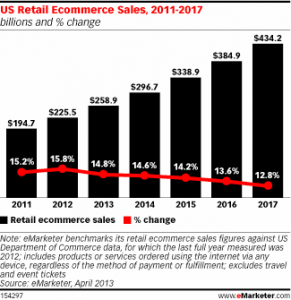Why develop ecommerce solutions: trends, demands and expectations

The global ecommerce market is estimated to total $631.7 billion in 2013 marking a compound annual growth rate of almost 19% between 2008 and 2013. The United States alone accounts for almost half of the global online retail market with its $259 billion e-tailing sector size (up 15% from 2012, see picture below).
With the mobile commerce catching up and accounting for 15% of all online retail sales (and expected to earn $39 billion in 2013), ecommerce obviously continues gaining momentum and steadily becomes a niche that every single company, regardless of its size and industry, tends to fill in. And today’s global ecommerce software market totaling $3 billion proves it. Do you need more arguments why ecommerce development is a backbone of your business success and boosted sales?
So, what are the current ecommerce trends that are likely to become the key game changers in 2014?
- Mobile optimization
According to TelecomPaper, global mobile penetration rate is predicted to reach 96% at the end of 2013. So, if you don’t see a lot of mobile traffic yet, it doesn’t mean you should ignore that expectation. If you don’t think proactively and fail to develop a mobile commerce solution for your target audience now, you’re at risk of losing sales significantly in the near future.
Also, such innovative ecommerce technologies as NFC and iBeacon in iOS 7 are expected to boost development of m-commerce in the months to come.
- Multi-device ecommerce solutions development
Did you know that 67% of users start shopping on one device and finish on anothervi? At least, that’s what Google says. As such, having your website, shopping cart and app optimized for different screens and mobile platforms will skyrocket your chance of getting more completed purchases!
- Seamless transactions
In our hectic world no one will wait for your app or site to process a purchase transaction if the response time is longer than 10 seconds! Make sure to optimize your ecommerce solution so that it will respond quickly and reliably to your business critical transactions during the peak load times. As such, always test your complete end-to-end checkout against numerous disparate processes and 3d party providers.
- Ongoing automated consumer tracking
Having a well-developed ecommerce solution is great, but some tech savvy retailers go even further by tracking bad customer experience occasions on a 24/7/365 basis and refunding customers in a proactive way. For this you need to develop an automated ecommerce system able to detect cases when your site and/or app’s performance falls below a pre-defined standard. This will allow you to fix an issue before it will actually occur and prevent your consumer from completing a purchase.
For your ecommerce development you’ll need the following basic technologies and languages:
- JavaScript to increase functionality
- PHP to connect your ecommerce website to the backend database
- HTML5 for better UI and frontend development
- MySQL to ensure interaction between your ecommerce website and database management system
And remember – effective ecommerce development requires a strong commitment to high performance of your digital assets, which, in turn, depends on true understanding of your end-user perspective.


